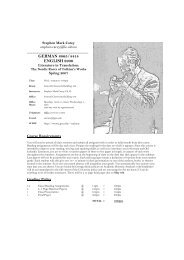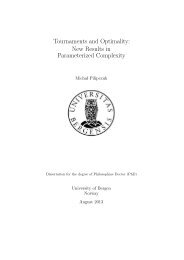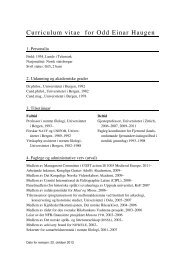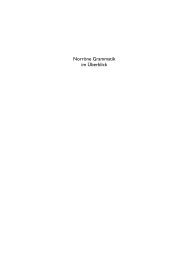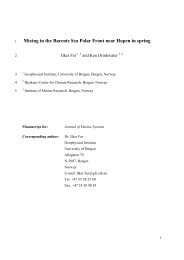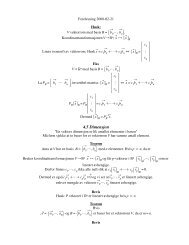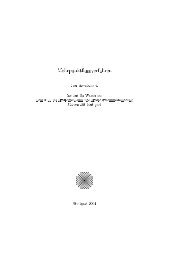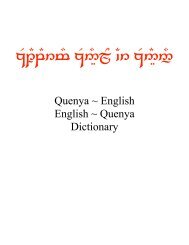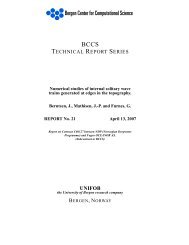Rational Curves in Calabi-Yau Threefolds
Rational Curves in Calabi-Yau Threefolds
Rational Curves in Calabi-Yau Threefolds
Create successful ePaper yourself
Turn your PDF publications into a flip-book with our unique Google optimized e-Paper software.
<strong>Rational</strong> <strong>Curves</strong> <strong>in</strong> <strong>Calabi</strong>-<strong>Yau</strong> <strong>Threefolds</strong> 3945<br />
g is the only smooth rational curve satisfy<strong>in</strong>g g < G and g.B < 0, we can<br />
write:<br />
G kg þ D<br />
for an <strong>in</strong>teger k 1 and D > 0 satisfy<strong>in</strong>g<br />
g 0 :B 0 for any smooth rational curve g 0 < D; ð28Þ<br />
D 2 ¼ 2ðk 2 þ 1Þ; ð29Þ<br />
D:L ¼ 9 k; whence k 8; ð30Þ<br />
D:B ¼ k 1: ð31Þ<br />
Now we claim that there has to exist a smooth rational curve g0 < D such<br />
that g0.B ¼ 0. Indeed, write D ¼ D0 þ D1, where D0 is the (possibly zero)<br />
mov<strong>in</strong>g part of jDj, and D1 its fixed part. (Note that D1 6¼ 0 by (29).) Then<br />
D 2<br />
0 0 and D0.D1 0, whence D 2<br />
1 D2 ¼ 2(k 2 þ 1). Now D1 is a f<strong>in</strong>ite sum<br />
of smooth rational curves, and let l denote the number of such curves,<br />
counted with multiplicities. One easily f<strong>in</strong>ds that D 2<br />
1 2l 2 (29)<br />
ffiffiffiffiffiffiffiffiffiffiffiffiffi<br />
, whence by<br />
l k2 p<br />
þ 1 > D:B ¼ k 1;<br />
and it follows that there is a smooth rational curve g 0 < D such that<br />
g 0.B ¼ 0, as claimed. But then disc(L, D, g 0) ¼ 18, which is not divisible<br />
by d ¼ 4, a contradiction. &<br />
Now we summarize the numerical conditions obta<strong>in</strong>ed <strong>in</strong> Lemmas<br />
5.5 and 6.1. We need d0 > ma 3<br />
3 a and want L to be very ample with<br />
Cliff L ¼ 1 and such that the rational normal scroll T S def<strong>in</strong>ed by the<br />
pencil jDj is smooth and of maximally balanced scroll type. Moreover,<br />
we need G to be smooth and irreducible.<br />
If m ¼ 4 this is satisfied if d0 > 4a 3<br />
3 a ,(d0, a) 6¼ (2, 2), (5, 4), (9, 7) and<br />
3d0 6¼ 4a when a 9. The latter means that the tuples (d0, a) ¼ (4, 3) and<br />
(8, 6) are allowed. We therefore obta<strong>in</strong> the follow<strong>in</strong>g values:<br />
For m ¼ 4 : ðd0; aÞ2fð4; 3Þ; ð8; 6Þg; or<br />
d0 > 4a<br />
3<br />
3<br />
a ; ðd0; aÞ 62fð2; 2Þ; ð5; 4Þ; ð9; 7Þg and 3d0 6¼ 4a:<br />
If m ¼ 5 this is satisfied if (d0, a) 6¼ (2, 2) and either d0 4ord0 2a<br />
(s<strong>in</strong>ce the cases (d0, a) ¼ (6, 4) and (13, 8) from Lemma 5.5 satisfy<br />
4 < d0 < 2a and s<strong>in</strong>ce also d0 2a implies d0 > 5a<br />
3<br />
3<br />
a ). We also f<strong>in</strong>d that



